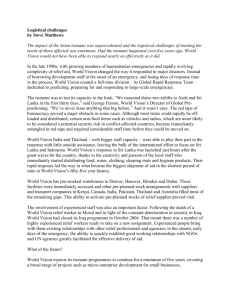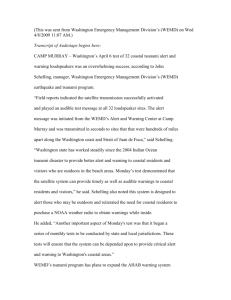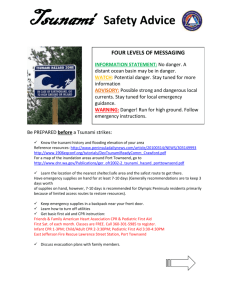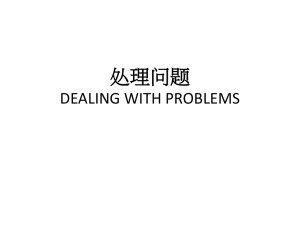Information & communication technology & institutions
advertisement
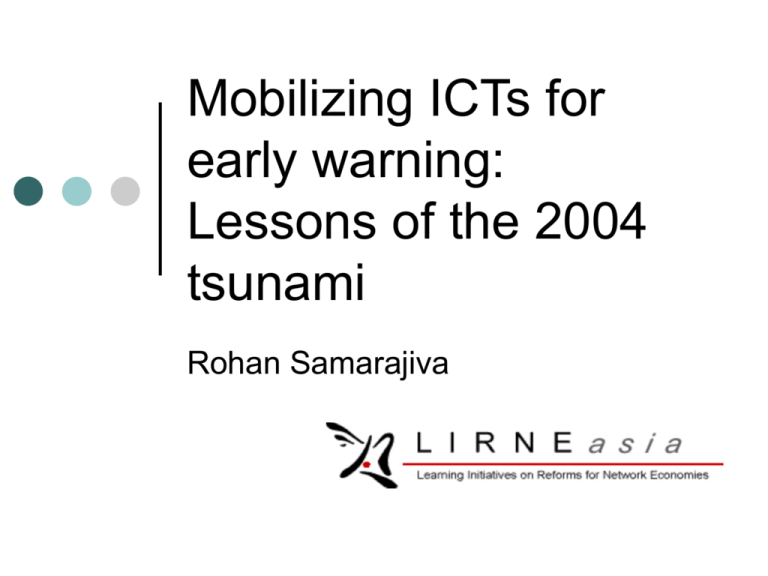
Mobilizing ICTs for early warning: Lessons of the 2004 tsunami Rohan Samarajiva World changing (?) disasters 1755 Lisbon earthquake, tsunami and fires (killing people worshipping in churches) 100,000 deaths Contributes to displacing religion from center of intellectual life 1883 Krakatoa volcanic implosion and tsunamis 35,000 deaths First disaster covered with help of undersea telegraphy 2004 Indian Ocean tsunami 200,000+ deaths & USD 4.5 billion in damage First Internet mediated natural disaster Physical and symbolic worlds, absent linking technologies Mediated interpersonal Symbolic world where action Physical world where originates hazards occur The physical, the symbolic & their linking through ICTs, simplified Warnings Mass media Physical world where hazards occur Warnings Mediated interpersonal Symbolic world where action originates Ideal form of hazard detection & monitoring and warning system Hazard detection & monitoring system Warning Center Warnings Physical world where hazards occur Mediated interpersonal Symbolic world where action originates Mass media Information & communication technology & institutions Physical world of hazards, symbolic worlds, link technologies & institutions that may/may not work Hazard detection & monitoring system Warning Center Warnings Physical world where hazards occur Mediated interpersonal Symbolic world where action originates Mass media Information & communication technology & institutions What happened in 10 out of 12 Indian Ocean countries* on December 26th, 2004 Mediated interpersonal Symbolic world where action Physical world where originates hazards occur * Excluding Kenya and Seychelles, which had the advantage of 7 hours How the world knew of the 2004 teletsunami Earthquake was known within minutes of its occurrence (0059 UTC) at Hawaii at Pacific Tsunami Warning Center Pallekale seismometer, and therefore by Sri Lanka Geological Survey & Mines Bureau • But none interpreted it as causing a teletsunami World’s best tsunami experts knew only when they read news reports from Sri Lanka, probably LBO report filed at 0333 UTC (next talk), or AFP reports filed at 0346 UTC in Colombo Why was Aceh’s scream not heard, unlike Sri Lanka’s? Aceh Telecom infrastructure was poor to start with, but was destroyed by earthquake and tsunami Civil war no journalists Sri Lanka’s east coast Cease fire of 2002 had allowed 100,000 + phones to go in Most of infrastructure survived Journalists free to report ICTs matter, but . . . But institutions matter even more ICTs are necessary conditions Institutions are the necessary conditions Why did the institutions fail? Despite completion of the International Decade for Natural Disaster Reduction in 1999, conferences, workshops, training courses . . . Why are they failing even now? With limited exception of Thailand, the tsunami affected countries have not got their act together even now, six months later Disaster warnings are classic public goods, subject to market failure Non rivalrous Non excludable Will be undersupplied by the market But government failure too Disaster warning systems Made up of Hazard detection & monitoring system • Regional/international (e.g., tsunami & cyclone) • Local (e.g., dam breaches, landslides) Warning & alert dissemination system Hazard information systems Regional and international systems subject to problems of intergovernmental coordination Thailand and India still squabbling National and local systems subject to government failure caused by Mindsets that privilege relief & recovery over preparedness and warning Multiple stakeholder problems Results of actions falling outside electoral cycles –Anthony Downs But government failure is not found in all countries . . . Possible the problem is limited to “predatory states” -- Peter Evans Driving force is rent seeking • Partly to get re-elected (Downs) • But venality too • Relief and recovery emphasis fits better with rent seeking Empirical evidence? Kaufmann, Kraay and Mastruzzi (2005) Government effectiveness? Control of corruption? No clear correlation, but worth further investigation Maldives, Thailand and Sri Lanka, countries that suffered significant losses, surprisingly high in percentile rankings Malaysia had highest/2nd highest relative scores but gave no warning Kenya had low scores but managed to issue warnings Distance and time Use of percentile ranking by Kaufmann et al. blurs gap between relatively less badly governed and well governed countries In conclusion . . . ICTs a necessary condition for warning ICTs, but also institutions Governance must be improved, but no need to improve all of it at once Public-private partnerships in Bangladesh: • “The cyclone of 1970 took the lives of 300,000 people but the cyclone of the same intensity of 1991 killed 138,000 people, and the cyclones of 1997 and 1998 resulted in only 127 and 6-7 deaths respectively” Good governance: the bulwark that saves lives For more . . . http://lirneasia.net Samarajiva, R. (2005, forthcoming). Mobilizing information and communications technologies for effective disaster warning: Lessons from the 2004 tsunami, New Media and Society

